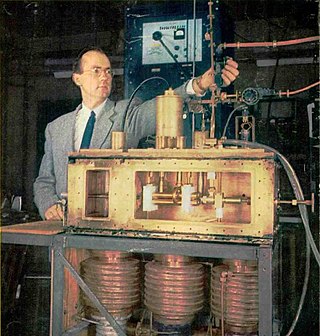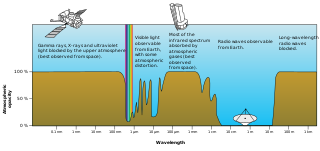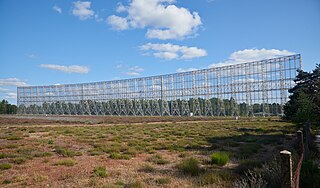
The electromagnetic spectrum is the full range of electromagnetic radiation, organized by frequency or wavelength. The spectrum is divided into separate bands, with different names for the electromagnetic waves within each band. From low to high frequency these are: radio waves, microwaves, infrared, visible light, ultraviolet, X-rays, and gamma rays. The electromagnetic waves in each of these bands have different characteristics, such as how they are produced, how they interact with matter, and their practical applications.

A maser is a device that produces coherent electromagnetic waves (microwaves), through amplification by stimulated emission. The term is an acronym for microwave amplification by stimulated emission of radiation. First suggested by Joseph Weber, the first maser was built by Charles H. Townes, James P. Gordon, and Herbert J. Zeiger at Columbia University in 1953. Townes, Nikolay Basov and Alexander Prokhorov were awarded the 1964 Nobel Prize in Physics for theoretical work leading to the maser. Masers are used as the timekeeping device in atomic clocks, and as extremely low-noise microwave amplifiers in radio telescopes and deep-space spacecraft communication ground stations.

Microwave is a form of electromagnetic radiation with wavelengths shorter than other radio waves but longer than infrared waves. Its wavelength ranges from about one meter to one millimeter, corresponding to frequencies between 300 MHz and 300 GHz, broadly construed. A more common definition in radio-frequency engineering is the range between 1 and 100 GHz, or between 1 and 3000 GHz . The prefix micro- in microwave is not meant to suggest a wavelength in the micrometer range; rather, it indicates that microwaves are small, compared to the radio waves used in prior radio technology.

Spectroscopy is the field of study that measures and interprets electromagnetic spectra. In narrower contexts, spectroscopy is the precise study of color as generalized from visible light to all bands of the electromagnetic spectrum.

A radio telescope is a specialized antenna and radio receiver used to detect radio waves from astronomical radio sources in the sky. Radio telescopes are the main observing instrument used in radio astronomy, which studies the radio frequency portion of the electromagnetic spectrum emitted by astronomical objects, just as optical telescopes are the main observing instrument used in traditional optical astronomy which studies the light wave portion of the spectrum coming from astronomical objects. Unlike optical telescopes, radio telescopes can be used in the daytime as well as at night.

Radio astronomy is a subfield of astronomy that studies celestial objects at radio frequencies. The first detection of radio waves from an astronomical object was in 1933, when Karl Jansky at Bell Telephone Laboratories reported radiation coming from the Milky Way. Subsequent observations have identified a number of different sources of radio emission. These include stars and galaxies, as well as entirely new classes of objects, such as radio galaxies, quasars, pulsars, and masers. The discovery of the cosmic microwave background radiation, regarded as evidence for the Big Bang theory, was made through radio astronomy.

Radio waves are a type of electromagnetic radiation with the lowest frequencies and the longest wavelengths in the electromagnetic spectrum, typically with frequencies below 300 gigahertz (GHz) and wavelengths greater than 1 millimeter, about the diameter of a grain of rice. Like all electromagnetic waves, radio waves in a vacuum travel at the speed of light, and in the Earth's atmosphere at a slightly slower speed. Radio waves are generated by charged particles undergoing acceleration, such as time-varying electric currents. Naturally occurring radio waves are emitted by lightning and astronomical objects, and are part of the blackbody radiation emitted by all warm objects.

Astrophysics is a science that employs the methods and principles of physics and chemistry in the study of astronomical objects and phenomena. As one of the founders of the discipline, James Keeler, said, Astrophysics "seeks to ascertain the nature of the heavenly bodies, rather than their positions or motions in space–what they are, rather than where they are." Among the subjects studied are the Sun, other stars, galaxies, extrasolar planets, the interstellar medium and the cosmic microwave background. Emissions from these objects are examined across all parts of the electromagnetic spectrum, and the properties examined include luminosity, density, temperature, and chemical composition. Because astrophysics is a very broad subject, astrophysicists apply concepts and methods from many disciplines of physics, including classical mechanics, electromagnetism, statistical mechanics, thermodynamics, quantum mechanics, relativity, nuclear and particle physics, and atomic and molecular physics.

Absorption spectroscopy is spectroscopy that involves techniques that measure the absorption of electromagnetic radiation, as a function of frequency or wavelength, due to its interaction with a sample. The sample absorbs energy, i.e., photons, from the radiating field. The intensity of the absorption varies as a function of frequency, and this variation is the absorption spectrum. Absorption spectroscopy is performed across the electromagnetic spectrum.

In the fields of Big Bang theory and cosmology, reionization is the process that caused electrically neutral atoms in the universe to reionize after the lapse of the "dark ages".

Observational astronomy is a division of astronomy that is concerned with recording data about the observable universe, in contrast with theoretical astronomy, which is mainly concerned with calculating the measurable implications of physical models. It is the practice and study of observing celestial objects with the use of telescopes and other astronomical instruments.

The hydrogen line, 21 centimeter line, or H I line is a spectral line that is created by a change in the energy state of solitary, electrically neutral hydrogen atoms. It is produced by a spin-flip transition, which means the direction of the electron's spin is reversed relative to the spin of the proton. This is a quantum state change between the two hyperfine levels of the hydrogen 1 s ground state. The electromagnetic radiation producing this line has a frequency of 1420.405751768(2) MHz (1.42 GHz), which is equivalent to a wavelength of 21.106114054160(30) cm in a vacuum. According to the Planck–Einstein relation E = hν, the photon emitted by this transition has an energy of 5.8743261841116(81) μeV [9.411708152678(13)×10−25 J]. The constant of proportionality, h, is known as the Planck constant.

Project Ozma was a search for extraterrestrial intelligence (SETI) experiment started in 1960 by Cornell University astronomer Frank Drake, at the National Radio Astronomy Observatory, Green Bank at Green Bank, West Virginia. The object of the experiment was to search for signs of life in distant planetary systems through interstellar radio waves. The program was named after Princess Ozma, ruler of the fictional land of Oz, inspired by L. Frank Baum's supposed communication with Oz by radio to learn of the events in the books taking place after The Emerald City of Oz. The search was publicized in articles in the popular media of the time, such as Time magazine and was described as the first modern SETI experiment.

The waterhole, or water hole, is an especially quiet band of the electromagnetic spectrum between 1420 and 1662 megahertz, corresponding to wavelengths of 21 and 18 centimeters, respectively. It is a popular observing frequency used by radio telescopes in radio astronomy.

A telescope is a device used to observe distant objects by their emission, absorption, or reflection of electromagnetic radiation. Originally it was an optical instrument using lenses, curved mirrors, or a combination of both to observe distant objects – an optical telescope. Nowadays, the word "telescope" is defined as a wide range of instruments capable of detecting different regions of the electromagnetic spectrum, and in some cases other types of detectors.
Wouthuysen–Field coupling, or the Wouthuysen–Field effect, is a mechanism that couples the excitation temperature, also called the spin temperature, of neutral hydrogen to Lyman-alpha radiation. This coupling plays a role in producing a difference in the temperature of neutral hydrogen and the cosmic microwave background at the end of the Dark Ages and the beginning of the epoch of reionization. It is named for Siegfried Adolf Wouthuysen and George B. Field.
The Dark Ages Radio Explorer (DARE) is a proposed NASA mission aimed at detecting redshifted line emissions from the earliest neutral hydrogen atoms, formed post-Cosmic Dawn. Emissions from these neutral hydrogen atoms, characterized by a rest wavelength of 21 cm and a frequency of 1420 MHz, offer insights into the formation of the universe's first stars and the epoch succeeding the cosmic Dark Ages. The intended orbiter aims to investigate the universe's state from approximately 80 million years to 420 million years post-Big Bang by capturing the line emissions at their redshifted frequencies originating from that period. Data collected by this mission is expected to shed light on the genesis of the first stars, the rapid growth of the initial black holes, and the universe’s reionization process. Moreover, it would facilitate the testing of computational galaxy formation models. Furthermore, the mission could advance research into dark matter decay and inform the development of lunar surface telescopes, enhancing the exploration of exoplanets around proximate stars.

The Nançay Radio Observatory, opened in 1956, is part of Paris Observatory, and also associated with the University of Orléans. It is located in the department of Cher in the Sologne region of France. The station consists of several instruments. Most iconic of these is the large decimetric radio telescope, which is one of the largest radio telescopes in the world. Long established are also the radio heliograph, a T-shaped array, and the decametric array operating at wavelengths between 3 m and 30 m.

The Hydrogen Epoch of Reionization Array (HERA) is a radio telescope dedicated to observing large scale structure during and prior to the epoch of reionization. HERA is a Square Kilometre Array (SKA) precursor instrument, intended to observe the early universe and to assist in the design of the full SKA. Along with MeerKAT, also in South Africa, and two radio telescopes in Western Australia, the Australian SKA Pathfinder (ASKAP) and the Murchison Widefield Array (MWA), the HERA is one of four precursors to the final SKA. It is located in the Meerkat National Park.


















